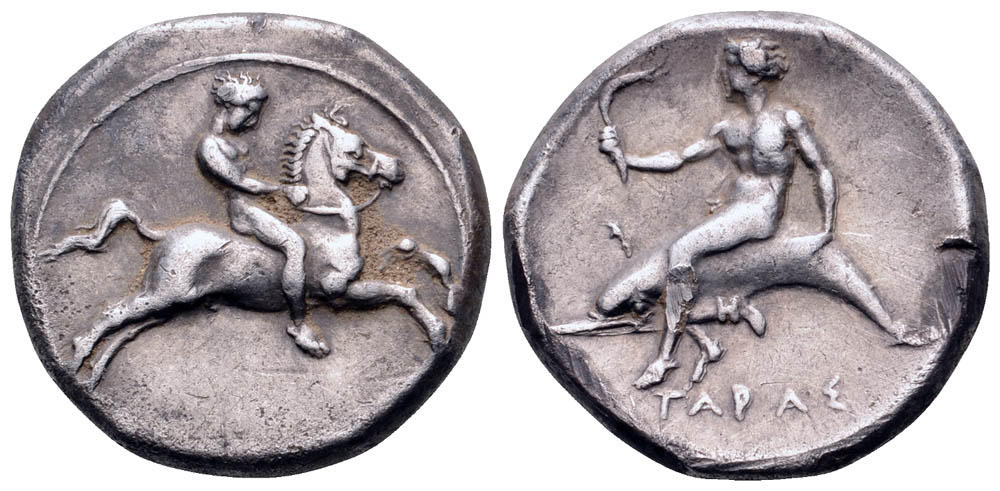Taras, silver, didrachms (390-380 BCE)
From SILVER
390 BCE - 380 BCE Silver 5,198 kg
Description
| ObverseInscription or printing placed on the obverse.: | Nude youth on horse galloping right, holding reins with both hands, all in linear circle |
| ReverseInscription or printing placed on the reverse.: | TAPAΣ (Greek).Taras, holding akrostolion in outstretched right hand, astride dolphin to left, H on dolphin's left flipper, TAPAΣ below, all in linear circle |
Mint and issuing power
| MintIdentifies the place of manufacture or issue of a numismatic object.: | Taras | Ancient regionAncient region.: | Calabria | Modern countryModern country: Italy | AuthorityIdentifies the issuing power. The authority can be "pretended" when the name or the portrait of X is on the coin but he/she was not the issuing power. It can also be "uncertain" when there is no mention of X on the coin but he/she was the issuing power according to the historical sources: |
Chronology
| FromIdentifies the initial date in a range assigned in a numismatic context. | 390 BCE | toIdentifies the final date in a range assigned in a numismatic context.. | 380 BCE | PeriodTime period of the numismatic object.: Classical 480-323 BC |
Physical description
| MetalThe physical material (usually metal) from which an object is made.: | Silver |
Median weightMedian of the weights of numismatic objects (in grams). in grams | 7.90 | DenominationTerm indicating the value of a numismatic object. Examples: tetradrachm, chalkous, denarius.: | didrachm |
StandardStandard.: |
Image

AC 23 - Taras, silver, didrachm, 390-380 BC.jpg [1]
References
| Die study referencePublication of the study: | Fischer-Bossert 19991Fischer-Bossert 1999, groups 27-31 (varieties 371-478 : O167-O203 et R290-R360). | ||
| Coin series referenceReference to coin series study: | Sear I2Sear I, n° 337, RQEMAC3RQEMAC, n° 23, HN Italy4HN Italy, n° 870 | ||
| Coin series web referenceCoin series web references: | |||
Obverse dies distribution
| FrequencyFrequency of specimen in distribution. ᵖ | Number of obversesNumber of obverse dies. ᵖ (o) | % (o) | Number of coinsNumber of coins. (n) | % (n) | Die nameName(s) of the die(s). |
| 1 | 3 | 9.09 | 3 | 0.71 | 181, 183, 187 |
| 3 | 2 | 6.06 | 6 | 1.43 | 194, 196 |
| 5 | 1 | 3.03 | 5 | 1.19 | 180 |
| 7 | 1 | 3.03 | 7 | 1.66 | 184 |
| 8 | 2 | 6.06 | 16 | 3.8 | 172, 188 |
| 9 | 2 | 6.06 | 18 | 4.28 | 182;195 |
| 11 | 3 | 9.09 | 33 | 7.84 | 170, 171, 190 |
| 12 | 2 | 6.06 | 24 | 5.7 | 173, 177 |
| 13 | 3 | 9.09 | 39 | 9.26 | 168, 185, 191 |
| 14 | 4 | 12.12 | 56 | 13.3 | 167, 179, 186, 198 |
| 15 | 1 | 3.03 | 15 | 3.56 | 189 |
| 16 | 2 | 6.06 | 32 | 7.6 | 192, 193 |
| 17 | 2 | 6.06 | 34 | 8.08 | 175, 176 |
| 21 | 1 | 3.03 | 21 | 4.99 | 178 |
| 22 | 1 | 3.03 | 22 | 5.23 | 174 |
| 24 | 1 | 3.03 | 24 | 5.7 | 169 |
| 32 | 1 | 3.03 | 32 | 7.6 | 199 |
| 34 | 1 | 3.03 | 34 | 8.08 | 197 |
| Total | 33 of 33 | 99.99 | 421 of 421 | 100.01 |
Reverse dies distribution
no distribution is available
Quantification
| Number of obversesNumber of obverse dies. ᵖ (o) | 33 | Number of singletons (o1)The number of singleton coins. ᵖ | 3 |
| Number of reverse diesNumber of reverse dies. (r) | 71 | Number of coinsNumber of coins. (n) | 421 |
| Coins per obverse dieNumber of coins per obverse die. (n/o) | 12.76 | Coins per reverse dieNumber of coins per reverse die. (n/r) | 5.93 |
| Reverse per obverse ratioRatio of obverse dies divided by reverse dies. (r/o) | 2.15 | Percentage of singletons (o1)number of coins (n) divided by the number of singletons (o1) ᵖ | 9.09 % |
| Original number of dies (O) (Carter 1983 formula)The estimation of the number of coins according to Carter 1983 ᵖ | 32.9 | Coins struck if 20,000 as average productivity per dieCoins made if the average productivity for obverses (according to Carter) is 20,000. ᵖ | 658,000 |
| Original number of dies (O) (Esty 2011 formula)The estimation of the number of coins according to the singleton formula in Esty 2011 ᵖ (O) | 35.81 | Survival rate if 20,000 as average productivity per dieSurvival rate if average productivity is 20,000. ᵖ | 0.00064 |
| Coverage (o = % of O) (Esty 1984 formula)Esty 1984 - coverage (% of O) ᵖ (o = % of O) | 99.29% | Die productivity if survival rate 1/2,000Average productivity if survival rate is 1/2,000. ᵖ | 25,592.71 |
| Weight of silver (in kg) if 20,000 coins per die (O = Carter formula)Carter 1983 * Median weight * 20000 (*10 if gold or electrum) ᵖ | 5,198 kg <br /> 5,198 kg | Die productivity if survival rate 1/5,000Average productivity if survival rate is 1/5,000. ᵖ | 63,981.76 |
Remarks
Most likely one single workstation Likely military A simple sequence most of the time but see p. 161 (obverses 199-203)